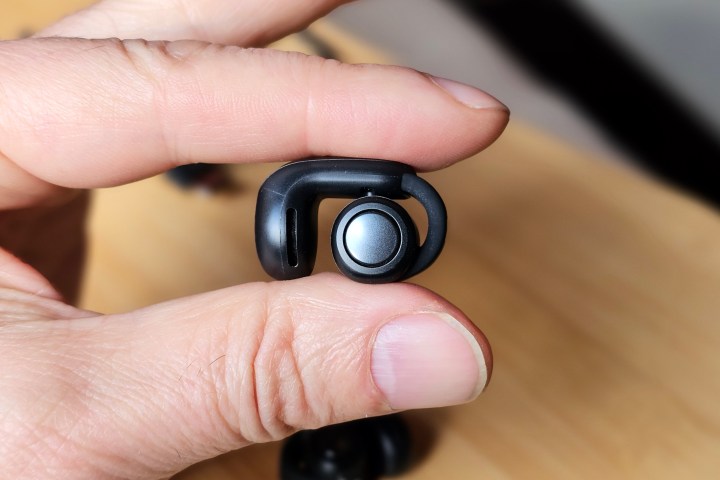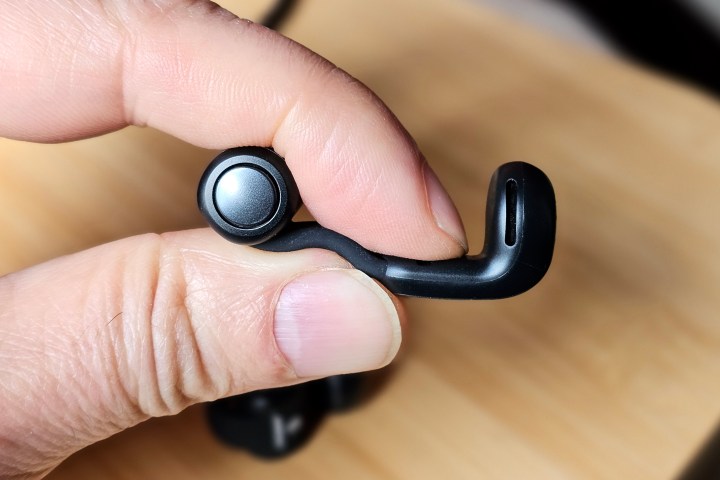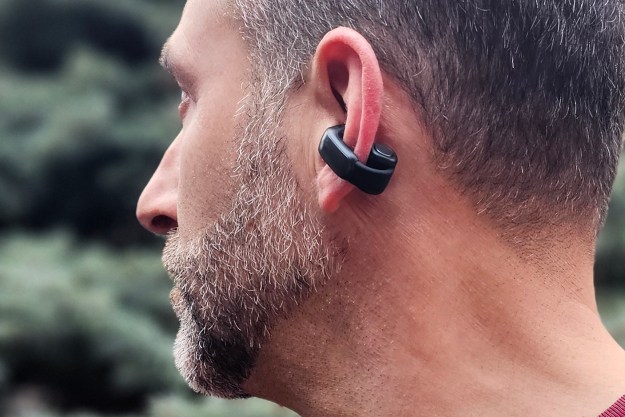
- Comfy, glasses-friendly shape
- Open, airy sound
- Excellent controls
- Impressive spatial audio
- Doesn't block your ears
- Expensive
- No wireless charging
- No Bluetooth Multipoint (yet)
Tired of your wireless earbuds blocking your ears and keeping you from hearing sounds around you? You’re not alone, and you’re not without options. Open-ear earbuds are an excellent choice for those who want to enjoy music and calls without sacrificing their situational awareness.
But if you’re someone who also wears glasses — either prescription or sunglasses (or both) — you may find that most open-ear earbuds seem to have one thing in common. They hook around the tops of your ears, right where your glasses sit.
Not so with Bose’s new Ultra Open Earbuds, which clip to the sides of your ears instead. It’s a bold design choice that’s as much fashion accessory as it is technology. They come with an equally bold price of $299, making them the most expensive open-ear earbuds you can buy. But to sweeten the deal, Bose has added head-tracked spatial audio, which it introduced with the QuietComfort Ultra Headphones and Ultra Earbuds.
Are they worth it? After using the Ultra Open Earbuds for two weeks, I think the answer is yes. But keep reading for my thoughts on who should buy them.
Bose Ultra Open Earbuds: design
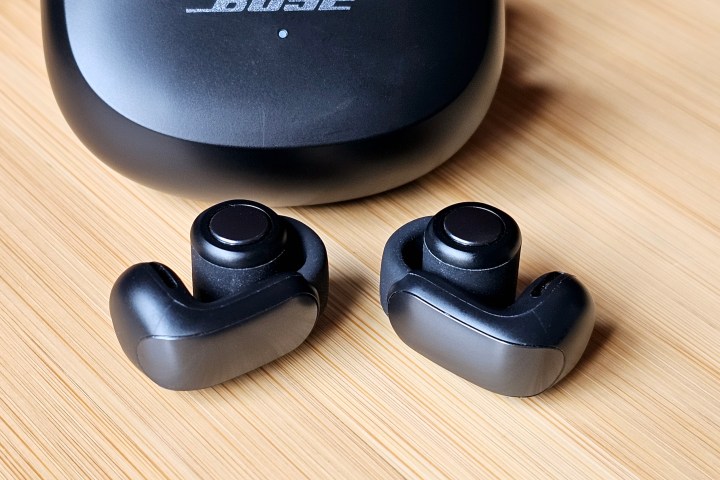
If you’re sick of the standard white golf tee look of the Apple AirPods and their legion of knockoffs, you’ve come to the right place. The Ultra Open Earbuds (which come in black or white) couldn’t be more different.
They look like a comma (or perhaps an apostrophe), with a barrel on one end and a hook-like shape on the other. They’re such a departure from traditional earbuds that it’s far from obvious how to wear them. When I initially pulled them from their charging case, I confidently shoved the barrel portion in my ear, using the hook to secure them. It fit, but I can assure you this is incorrect.
It’s actually the hook that goes inside your concha first (it contains the speaker), then, while gripping the barrel, you wrap the barrel portion (battery and controls) around and behind the part of your ear called the helix.
Thanks to the flexible rubberized connection between the barrel and hook, it’s less awkward than it sounds. You get faster at it the more you do it.
If getting them on and off your ears takes practice, the opposite is true of getting the Ultra Open Earbuds in and out of their charging case. Unlike most earbuds that need to be plucked (sometimes with difficulty) from their charging crevices, the Ultra Open sit fully exposed — held in place only by their powerful magnets.
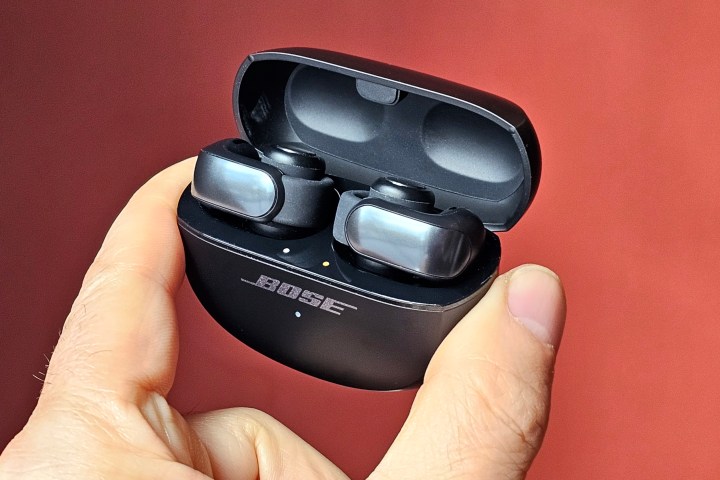
I’ve never seen a set of buds that are this easy to access. Putting them back might be even easier — simply bring them within a few millimeters of their assigned charging spots and those magnets grab them from your fingers and snap them in place.
Another benefit to the Ultra Open’s unusual shape is the size of their case. Most open-ear models use earhooks. This requires bigger, bulkier cases. The Ultra’s case is actually smaller than the one that accompanies the Bose QuietComfort Ultra Earbuds.
Unfortunately, the case doesn’t have wireless charging. You’ll have to use the included USB-A to USB-C cable. If you want wireless charging, Bose plans to sell a wireless charging silicone cover — the same ridiculous solution it designed for its QuietComfort Ultra Earbuds. It’s 2024 and there’s simply no acceptable reason for a set of nearly $300 wireless earbuds to omit this handy feature.
I’m also a little concerned about the case’s lid. Even when closed, it can twist out of shape a bit, leading me to think that either the hinge isn’t wide enough, or the lid’s plastic isn’t rigid enough.
Despite the fact that Bose intends the Ultra Open Earbuds to be worn all day, in a variety of situations, they only have IPX4 protection from water and no dust protection at all. In other words, a bit of sweat or rain should be fine, but they are not going to stand up to rougher use.
Bose Ultra Open Earbuds: comfort, controls, and connections
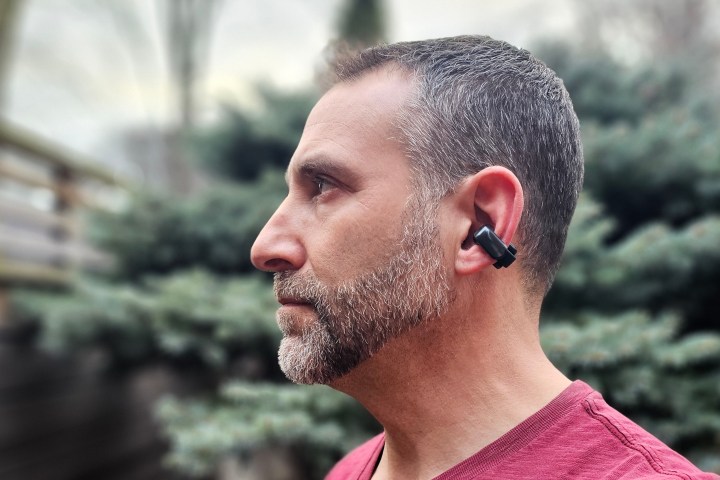
With their unusual design, few folks will forget you’re wearing a set of Bose Ultra Open Earbuds, but you just might. Once I had them on my ears, I was barely aware of them. I’ve found this to be true of most open-ear earbuds I’ve tried, but the Ultra Open Earbuds are especially comfortable for long sessions.
They’re not perfect — I eventually noticed some pressure where the barrel sits against the back of my helix — but they can also be adjusted. I was able to slide them higher or lower to change that pressure point. They’re on par with the excellent Shokz OpenFit, except for the Ultra Open Earbuds’ big benefit: they don’t interfere with glasses.
Not that the whole glasses thing is a major problem with earhook-style buds, but with the Ultra Open Earbuds, you don’t think about it at all.

Another big benefit to Bose’s design is the controls. A single physical button occupies the top of each barrel, which is easily clicked by putting your thumb on the barrel bottom while pressing the button with your index finger (like the OK hand sign). This turns out to be one of the easiest, most intuitive earbud controls I’ve ever used, and it works just as well with gloved hands.
By default, you get playback/call control and track control via single, double, and triple clicks. A long-press handles a preselected shortcut (more on this in a moment), and the left and right buds have volume down/up gestures, respectively. Of these, only the shortcut gesture can be customized in the Bose Music app (iOS, Android.)

There are no wear sensors, but there’s no need to remove an earbud for conversations — simply pressing the pause button is enough.
With Bluetooth 5.3, the Ultra Open Earbuds are easy to connect, especially on Android devices where Google Fast Pair makes it a one-click process. Plus, they’re future-proofed for the eventual support of features like LE Audio and Auracast. Unfortunately, neither is available out of the box, though Bose says both are on its radar.
More surprisingly though, is the lack of Bluetooth Multipoint. Open-ear earbuds are perfect for those who want to switch from one device to another throughout the day — Bose calls it the “one bud phenomenon” — but without Multipoint, that promise of freedom quickly becomes the reality of frustration. Again, Bose says this omission will be addressed with an update, but it hasn’t offered concrete timing other than promising it for 2024.
While we wait for Multipoint to arrive, Bose has a stopgap measure of sorts. You can program the long-press shortcut gesture to hop the Ultra Open Earbuds from their existing wireless connection to the next device in your list. It’s not as seamless or as convenient as true Multipoint, but it’s far better than having to reach for your phone or pull up the Bluetooth menu on your computer.
Each bud can have different shortcut functions, and your other choices are voice assistant access, immersive audio switching, or mode cycling. On Bose QuietComfort products, modes make sense — they let you assign different combinations of ANC and immersive audio into a single setting.
But on the Ultra Open, it’s somewhat superfluous. The only thing you can add to a mode is an immersive audio setting, and these are already accessible via the immersive audio switching shortcut. The one benefit appears to be the ability to eliminate one of the three immersive audio options, letting you toggle between two.
Bose Ultra Open Earbuds: sound quality

For open-ear earbuds to provide situational awareness, they have to let a lot of outside sound in. That’s kryptonite for audio fidelity, and there’s no getting around it — the louder your environment, the harder it will be to enjoy your music.
I can’t stress this enough: you will hear your music, but you will hear everything else, too. Nonetheless, the Bose Ultra Open Earbuds manage to do a better job at this balancing act than the competition.
It’s not just that Bose knows how to extract great sound quality from small drivers — it’s also a result of the Ultra Open Earbuds’ design. Most open-ear earbuds position their drivers in front of and just above the ear’s concha. The Ultra Open Earbuds’ curly shape, on the other hand, puts the earbuds’ drivers inside the concha, where they’re closer to your ear canals, while simultaneously using the ear’s natural contours to shield them. A side benefit of this arrangement is that they leak far less of their own sound to the outside world.
The overall result is impressive, especially in quiet locations. Instead of pushing audio into your ears like normal earbuds — which can be intense, particularly when listening to lower frequencies — the Ultra Open Earbuds create an airy, natural listening experience that does a better job of simulating a set of stereo speakers. They’re the earbud equivalent of open-back headphones.
Bass, which is usually the first victim of open designs, remains potent. It doesn’t thump, but it still carries plenty of weight and resonance. Midrange details are another strength. In quiet locations, they let me hear many subtleties. Higher frequencies can be a tad on the strident side, but are always clear and focused.
Bose includes a set of four EQ presets to help fine-tune the sound to your liking, but these are subtle tweaks at best. You won’t be able to massively alter the factory tuning.
I was especially impressed with Bose’s Immersive Audio setting, which gives any stereo sound the spatial audio treatment. The effect is very convincing — it puts two virtual stereo speakers a few feet in front and above your listening position.
Though still not a must-have feature, I think Bose’s spatial tech works better than that of Apple, Jabra, and Soundcore. Add the open architecture of the Ultra Open Earbuds, and you’ve got an ideal platform for getting the most out of the 3D-like effect.
Like the QuietComfort Ultra Earbuds (and Headphones), you can choose between “still” — the head-tracked version — and “motion,” which maintains spatial audio, but disables head tracking. The key difference is that still mode creates the illusion that the two virtual speakers are in the same room as you, but fixed in place, directly in front of your listening position. With motion mode, those speakers move in sync with your head movements, which is how traditional headphones work.

There’s also an auto-volume feature that can be enabled in the Bose Music app. When it’s on, the earbuds try to increase the volume based on your surroundings, to keep the same relative volume you had set when in a quieter location — and it’s a good idea in theory. Unfortunately I found it didn’t kick in when I wanted it to, and when it did, it often took me by surprise. Its ability to do this depends on your chosen volume level — if you start at 90%, there’s not much it can do to make things louder.
Finally, it’s worth mentioning that with Qualcomm’s Snapdragon Sound tech, the Ultra Open Earbuds give you the full range of aptX codecs, including aptX Lossless, for CD-quality wireless sound (assuming you have a compatible Android phone). You may notice a difference in controlled, quiet settings — I found my Motorola ThinkPhone delivered a smoother, more nuanced sound than my iPhone 14 — but these benefits will be instantly lost the moment you step outside.
Before you rush to hit the buy button, there are two things you need to know, especially if you’ve never used open-ear earbuds before.
First, when you’re in noisy environments, listening to spoken-word content like podcasts or phone calls can be challenging. You will miss things and you’ll likely have to ask people to repeat themselves. Keep that in mind if you’re going to be using these while at a gym or walking on busy streets.
Second, sound quality and volume levels will be affected by fit. This is true of any set of earbuds, but it’s particularly noticeable on a product like the Bose Ultra Open Earbuds, which have a variety of possible positions on your ear. Be prepared to experiment.
Bose Ultra Open Earbuds: call quality

I love using open-ear earbuds for phone calls and video chats. Few people discuss it, but I think it’s a highly underrated aspect of these devices. Because you can hear your own voice as clearly as if you weren’t using headphones at all, it’s a natural way to talk and far less fatiguing than with regular earbuds — even those with a transparency mode.
On the other side of the equation, your callers should hear you clearly most of the time. Outdoors, the Ultra Open Earbuds occasionally struggle with loud competing sounds. Your voice may sound distant or thin. The fidelity gets better indoors.
Bose Ultra Open Earbuds: battery life
Bose claims the Ultra Open Earbuds get up to 7.5 hours of battery life on a single charge, and the charging case can boost that to 27 hours. However, Bose’s Immersive Audio mode appears to be very power-hungry. If you leave it turned on, battery life drops to 4.5 and 16.5 hours respectively.
And most power estimates are based on listening at a 50% volume level. That may be enough when inside, but you will likely want it higher when outside.
While that’s not brilliant for wireless earbuds, the Ultra Open Earbuds should still be able to get you through a full day. You likely won’t be listening to music continuously, and even if you do, a quick charge of 10 minutes gets you an extra two hours of use.
Open-ear earbuds aren’t for everyone. They can’t deliver thumping bass, and the very thing that makes them appealing (being able to hear your surroundings) is also the thing that limits their audio quality. And yet, if you’re tired of jamming hard plastic objects into your ears and then having to yank them out just to order a coffee, the Bose Ultra Open Earbuds are a fantastic alternative.
They cost more than they should considering their lack of wireless charging, and I’m nonplussed at their current lack of Bluetooth Multipoint. However, they sound better than any other open-ear model I’ve tried so far, their unusual shape is ideal for wearing glasses, and their already open and airy sound is the perfect platform for their spatial audio tech.
Like the idea of open-ear earbuds, but you’re not ready to make a $300 investment? Our roundup of the best open-ear earbuds has several great options at varying prices, but here are three models I think are worth a closer look: The Oladance OWS2 ($149) sound great, but are a bit bulky. The Shokz OpenFit ($180) are incredibly comfortable. And if you need a non-earhook design, Sony’s intriguing LinkBuds ($180) are exceptional for making calls.

